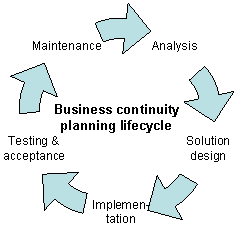
Interoperability is a characteristic of a product or system to work with other products or systems. While the term was initially defined for information technology or systems engineering services to allow for information exchange, a broader definition takes into account social, political, and organizational factors that impact system-to-system performance.

Business continuity may be defined as "the capability of an organization to continue the delivery of products or services at pre-defined acceptable levels following a disruptive incident", and business continuity planning is the process of creating systems of prevention and recovery to deal with potential threats to a company. In addition to prevention, the goal is to enable ongoing operations before and during execution of disaster recovery. Business continuity is the intended outcome of proper execution of both business continuity planning and disaster recovery.
The ISO 9000 family is a set of five quality management systems (QMS) standards by the International Organization for Standardization (ISO) that help organizations ensure they meet customer and other stakeholder needs within statutory and regulatory requirements related to a product or service. ISO 9000 deals with the fundamentals and vocabulary of QMS, including the seven quality management principles that underlie the family of standards. ISO 9001 deals with the requirements that organizations wishing to meet the standard must fulfill. ISO/TS 9002 offers guidelines for the application of ISO 9001. ISO 9004 gives guidance on achieving sustained organizational success.
In the context of software engineering, software quality refers to two related but distinct notions:
Data quality refers to the state of qualitative or quantitative pieces of information. There are many definitions of data quality, but data is generally considered high quality if it is "fit for [its] intended uses in operations, decision making and planning". Moreover, data is deemed of high quality if it correctly represents the real-world construct to which it refers. Furthermore, apart from these definitions, as the number of data sources increases, the question of internal data consistency becomes significant, regardless of fitness for use for any particular external purpose. People's views on data quality can often be in disagreement, even when discussing the same set of data used for the same purpose. When this is the case, data governance is used to form agreed upon definitions and standards for data quality. In such cases, data cleansing, including standardization, may be required in order to ensure data quality.
Quality management ensures that an organization, product or service consistently functions well. It has four main components: quality planning, quality assurance, quality control and quality improvement. Quality management is focused not only on product and service quality, but also on the means to achieve it. Quality management, therefore, uses quality assurance and control of processes as well as products to achieve more consistent quality. Quality control is also part of quality management. What a customer wants and is willing to pay for it, determines quality. It is a written or unwritten commitment to a known or unknown consumer in the market. Quality can be defined as how well the product performs its intended function.
The ISO/IEC 11179 metadata registry (MDR) standard is an international ISO/IEC standard for representing metadata for an organization in a metadata registry. It documents the standardization and registration of metadata to make data understandable and shareable.

GS1 is a not-for-profit, international organization developing and maintaining its own standards for barcodes and the corresponding issue company prefixes. The best known of these standards is the barcode, a symbol printed on products that can be scanned electronically.
Geospatial metadata is a type of metadata applicable to geographic data and information. Such objects may be stored in a geographic information system (GIS) or may simply be documents, data-sets, images or other objects, services, or related items that exist in some other native environment but whose features may be appropriate to describe in a (geographic) metadata catalog.
International standards in the ISO/IEC 19770 family of standards for IT asset management address both the processes and technology for managing software assets and related IT assets. Broadly speaking, the standard family belongs to the set of Software Asset Management standards and is integrated with other Management System Standards.
A specification often refers to a set of documented requirements to be satisfied by a material, design, product, or service. A specification is often a type of technical standard.

The Code Management Association [US-DE.BER:3031657] trading as the Electronic Code Management Association (ECCMA) is an international not for profit membership association founded in 1999 with mission to research, develop and promote better quality data for use in electronic commerce.
eOTD is the acronym for the ECCMA Open Technical Dictionary. The dictionary is a language-independent database of concepts with associated terms, definitions and images used to unambiguously describe individuals, organizations, locations, goods, services, processes, rules, and regulations. The eOTD is maintained by the Electronic Commerce Code Management Association (ECCMA).
ECLASS is a data standard for the classification of products and services using standardized ISO-compliant properties. The ECLASS Standard enables the digital exchange of product master data across industries, countries, languages or organizations. Its use as a standardized basis for a product group structure or with product-describing properties of master data is particularly widespread in ERP systems.



